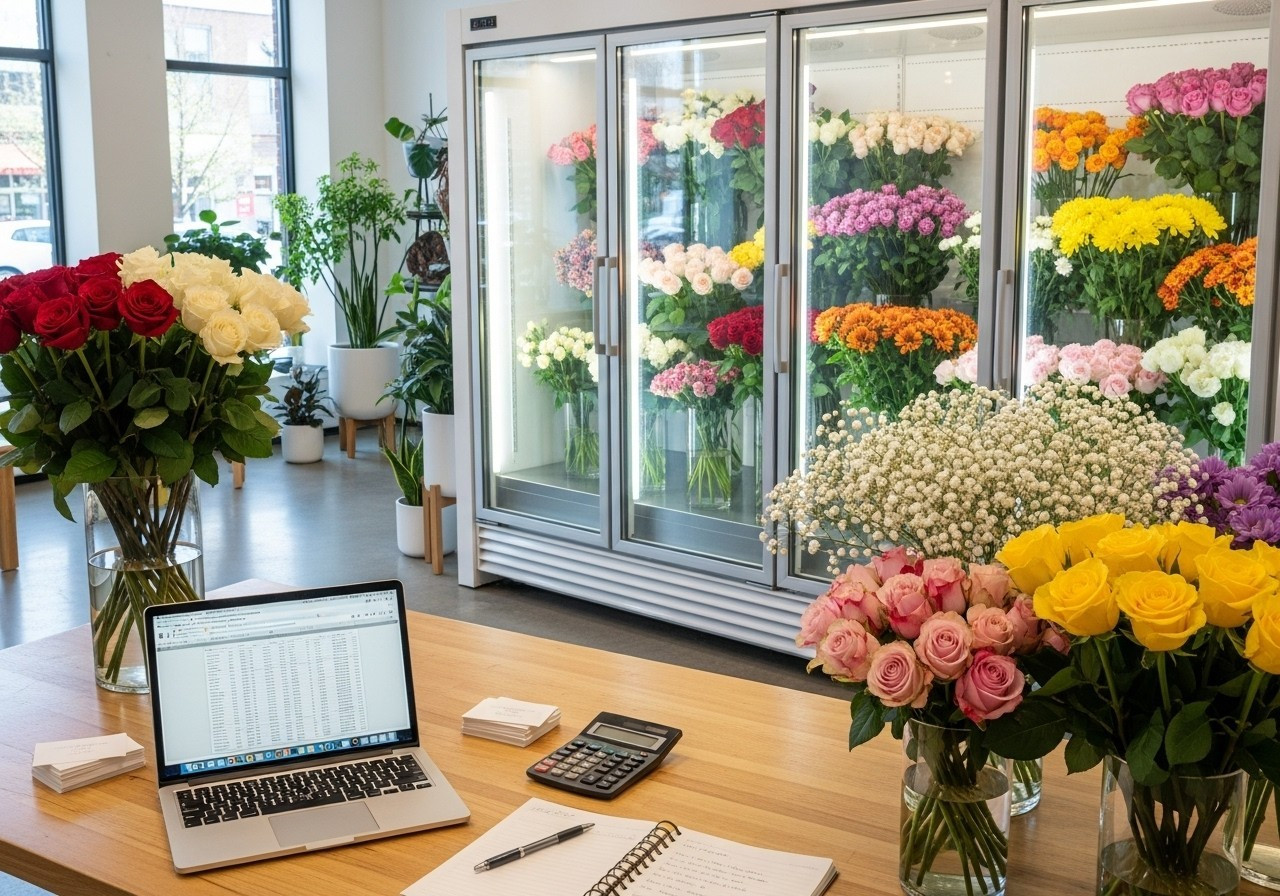The flower market in Russia is one of the few retail segments that maintains steady growth even in an unstable economy. According to WTC Moscow, in January-February 2025 alone, 365 million cut flowers were imported into the country—17% more than in the same period in 2024. The online segment continues to grow at an accelerated pace: over the past four years, the number of online orders has nearly tripled, as confirmed by data from Forbes.
This growth opens up new opportunities for entrepreneurs—especially those who can skillfully build a supply chain, adapt their product range to demand, and leverage digital channels as a cornerstone of their business.
Introduction to the Russian Flower Market
Current Volumes and Dynamics
By the end of 2024, the Russian cut flower market reached a volume of 2.09 billion units—a 5% increase compared to the previous year. This data confirms that the market has fully recovered from the pandemic-related downturn and has even surpassed pre-crisis levels.
Imports remain the primary source of supply, accounting for about 80% of sales volume. The main supplier countries are Ecuador, Kenya, Colombia, and the Netherlands. This makes logistics and the cold chain key factors for competitiveness.
Moreover, growth is driven not only by offline retail but also by online sales: according to RBC Marketing, the number of online orders in 2024 increased 2.8-fold compared to 2020. This solidifies the position of e-commerce as one of the key sales channels in the industry.
Key Demand Drivers
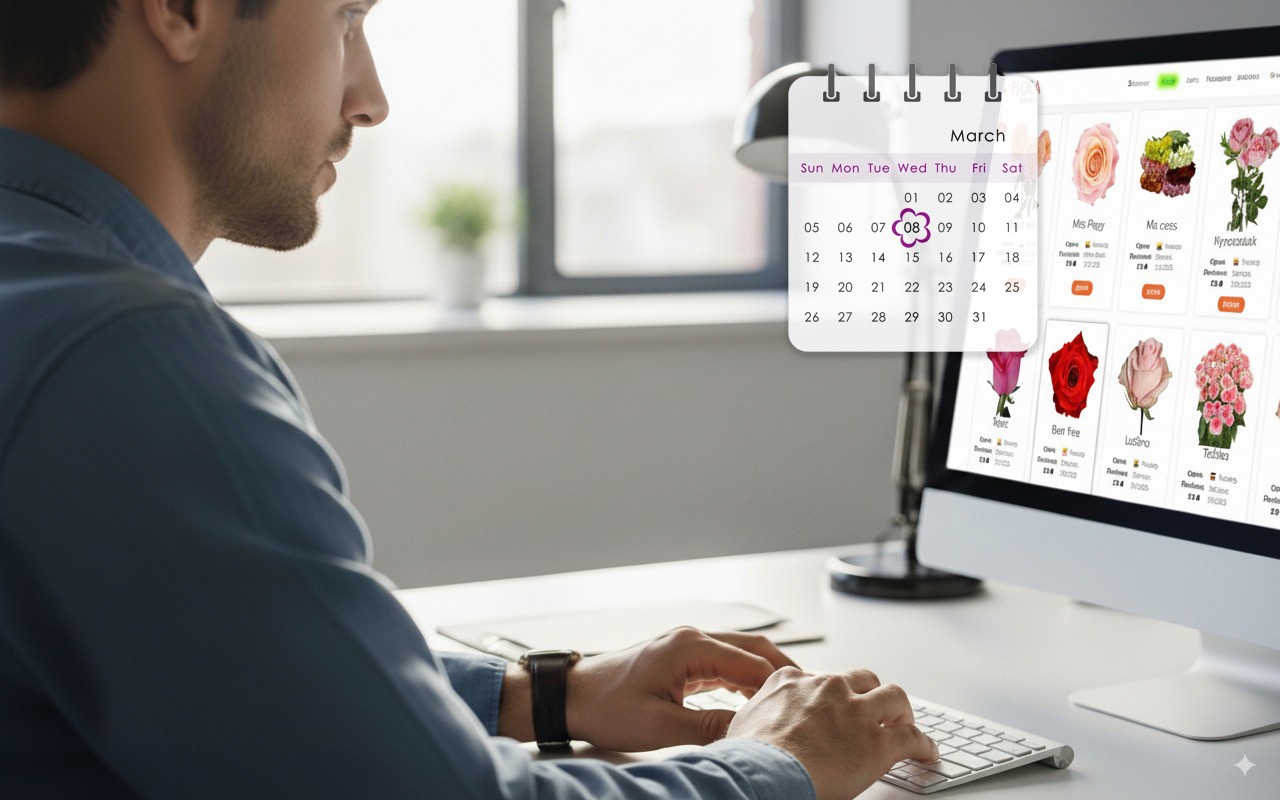
Sales in flower retail are distributed unevenly throughout the year, with pronounced peaks during holiday periods. Three calendar dates—March 8th, September 1st, and New Year's Day—account for up to 45% of the annual revenue for most market players.
Another important segment is corporate clients. Subscriptions for regular bouquet deliveries to offices, events, and business center lobbies provide stable margins and predictable revenue. These clients value delivery reliability and strict adherence to deadlines, making service and logistics critically important.
It is also worth noting the growing interest in custom-designed bouquets. The shift from standard options—like 11 roses in cellophane—to individually arranged compositions increases both the average check and customer loyalty. Such bouquets are perceived as a personal gesture rather than a formal gift.
Regional Focus #1
The online channel shows particularly high growth rates in major metropolitan areas. In Moscow, the share of online sales in flower retail has already reached 30%. In other major cities—such as Krasnoyarsk, Voronezh, and Samara—this figure is in the 18–22% range and continues to grow.
This influences the choice of store format. In Moscow and St. Petersburg, the optimal solution is a dark store—a warehouse-florist studio prioritizing fast delivery within 1–2 hours. Customers in these cities expect speed, assortment flexibility, and high-precision service, rather than a physical storefront on a busy street.
In the regions, by contrast, the classic model with an offline salon and a display window is still effective. There, factors like trust, physical presence, and visual contact with the products are important. However, even in these cities, digital promotion is becoming essential: a search for "flowers near me" on maps and social media often determines where a customer will go to buy a bouquet.
Market Research and Niche Selection
Before renting a space and ordering the first batch of roses, an entrepreneur must determine who they will sell flowers to and why. It is at this stage that the sustainability of the future business model is established.
Defining the Target Audience
The store format, assortment, logistics, and even packaging design must be adapted to specific consumer segments. Trying to cater to everyone at once often leads to a diluted USP and unprofitable expenses.
Below is a basic structure of target segments, linked to demand types and expected margins:
| Segment | What They Buy | Selection Criteria | Profit Margin* |
|---|---|---|---|
| Event Agencies | Large batches of single-color roses, greenery for decor | Reliable logistics and on-time delivery | 25–30% |
| Corporate Clients | Subscriptions for "office" bouquets, gift arrangements | Service with delivery guarantees (within 2 hours), fiscal documents | 30–35% |
| Private Customers | Everyday bouquets, custom arrangements, houseplants | Aesthetics, price, convenience, and speed of purchase | 40%+ |
*Markup based on data from CRM Flowwow and "Growth Technologies" research, RBC
This segmentation helps build a product line: for example, a bouquet of seasonal wildflowers can be sold at a higher price than the standard "11 red roses" by emphasizing emotional value and uniqueness.
Competitor and Location Analysis
Understanding the target audience is incomplete without assessing the current landscape. Even in saturated markets, it's often possible to find "empty" niches—for example, a lack of express delivery or a weak offering for B2B clients.
A basic checklist for assessing competitors by location:
- Prices—compare the 10 most popular items (roses, alstroemeria, packaging).
- Assortment—availability of custom bouquets, houseplants, small complementary gifts.
- USP—are there workshops, a "bouquet of the week" subscription, a 2-hour delivery guarantee.
- Coverage Radius—delivery map for 3/5/10 km; the wider the area, the higher the logistics costs.
The collected data can be conveniently entered into a differentiation matrix table. This allows for the quick identification of underserved niches—for example, a lack of professional services for business centers in the area.
Research Tools
Digital tools are available for market analysis that do not require significant investment:
- Wordstat—helps assess demand seasonality and the frequency of queries like "bouquet for September 1st".
- Google Trends—shows the popularity of trends ("dried flowers," "DIY bouquet kit").
- 2GIS—visually demonstrates the density of flower shops in an area.
- Polls on VK/Telegram—allow for quick hypothesis testing: is a subscription important? What is the average check?
Business Planning and Finance
A successful flower shop is not just about creativity, but also precise calculations. Even when starting small, it's important to create a clear business model with forecast figures and a cost control system.
Creating a Business Model (BMC)
One effective tool is the Business Model Canvas (BMC). It is a simple, one-page diagram that helps structure the main elements of a project:
- Customers—event agencies, corporate clients, private customers.
- Value Proposition—2-hour delivery, custom bouquets, avoiding Oasis floral foam.
- Channels—offline location, Instagram catalog, Flowwow marketplace (via API).
- Customer Relationships—loyalty programs, SLAs with businesses.
- Revenue Streams—55% offline, 30% online, 15% subscriptions.
- Key Resources—12 m³ refrigerator, CRM, photo studio for content.
- Key Activities—purchasing, assembly, delivery, promotion.
- Key Partners—Cargo Flowers (imports), local greenhouses.
- Cost Structure—48% purchasing, 22% rent, 15% personnel, 5% marketing, 10% other.
Financial Forecast (12-month P&L)
At the start, it's important to understand how much money will be needed and how quickly the business will become profitable. A P&L (profit and loss) statement is a report on income and expenses that helps assess projected profitability. A typical one-year forecast looks like this:
| Indicator | M1 | M6 | M12 |
|---|---|---|---|
| Revenue, RUB | 1.2 million | 2.6 million | 4.1 million |
| Gross Margin | 42% | 44% | 46% |
| Operating Expenses | 750k | 1.1 million | 1.6 million |
| Earnings Before Interest, Taxes, Depreciation, and Amortization (EBITDA) | –180k | +120k | +420k |
| Break-even Point | — | — | 7th month |
The calculation is based on sales growth from 35 bouquets per day (in the first month) to 80 by December.
Financing Options
Funding sources depend on the scale and region:
- Personal funds—minimal risk, but a limited budget.
- SME microloans—up to 5 million RUB at 9–10% per annum, with approval in 10 days. Interest rates, financing amounts, and review times may vary; be sure to confirm these details when planning your business.
- Crowdlending—this is peer-to-peer lending where private investors loan money to a business for interest. It works particularly well in large cities where people are willing to invest in understandable and relatable projects (average investment: 30–50k RUB).
- Factoring—bank financing against flower purchases, useful during seasons of peak expenses.
Regional Focus #2
Rental cost is one of the main factors in the financial model. In Moscow, rates for street retail in residential areas start at 4,000 RUB/m² per month. For example, a 55 m² pavilion in the Lyublino district would cost 250k RUB monthly (source).
In Yekaterinburg and other cities with over a million people, rates are lower—1,500–2,000 RUB/m², resulting in a rental payment of 70–80k RUB for a similar space (Forbes).
This gap directly affects the financial model. While a Moscow location might break even in the 9th month, a similar project in Yekaterinburg could become profitable by the 6th month, due to savings on rent and lower overhead costs.
Legal Requirements
Before launching a flower shop, it's crucial not only to develop a business model but also to properly handle legal paperwork. Non-compliance can lead to fines and risks for future operations.
Business Registration and OKVED Code 47.76
The optimal form for starting out is a sole proprietorship (IP) under the simplified tax system (USN) with a rate of 6% of revenue. For more ambitious plans or if there are multiple founders, registering an LLC under the "income minus expenses" simplified tax system should be considered.
When submitting documents to the Federal Tax Service, it's important to specify the activity code 47.76.1—"retail trade of flowers, plants, seeds, and fertilizers." This code covers both traditional in-store sales and home delivery of bouquets (source).
A separate code for online delivery is not required: under current regulations, delivery is considered a method of selling goods, not a separate business activity.
Licenses, Sanitary Standards, and "Honest SIGN" Labeling
Selling cut flowers does not require a license. The only mandatory requirement is to have phytosanitary certificates from import suppliers, confirming product safety.
There are no separate sanitary regulations for flower shops; however, Rospotrebnadzor follows standard storage conditions: a temperature of +2 to +6 °C and humidity in the 75–85% range.
The mandatory "Honest SIGN" labeling system, being implemented in Russia from 2024–2025, does not yet apply to flowers (RBC). However, if the shop also sells toys or greeting cards that fall into labeled product groups, they must be accounted for under separate rules.
Cash Register Discipline and Federal Law 54-FZ
As of March 1, 2025, amendments to Federal Law No. 54-FZ on cash register equipment come into force:
- Registration and re-registration of cash registers will transition entirely online. Applications are submitted through a fiscal data operator, and the processing time is reduced to 5 business days. Additionally, from September 1, 2025, documents can be submitted via the "Gosuslugi" portal or the cash register manufacturer's personal account (source, FTS).
- Each cash register requires a separate fiscal drive. The Federal Tax Service is authorized to set requirements for print quality and the size of the QR code on receipts.
- An online cash register is mandatory for all transactions with customers: payment via SBP, courier at the doorstep, self-service kiosks, etc. The requirement for couriers has been in effect since 2019; the new version of the law only confirms and details it (source).
- Sole proprietors on simplified, patent, and other tax systems must use cash registers unless they fall into a narrow list of exceptions (Clause 2, Art. 2 of 54-FZ). The "up to 12 months without a cash register" exemption is only retained for trade at fairs and small markets—stationary pavilions are not eligible (source).
What Varies Between Regions
Legal and tax conditions differ in each constituent entity of the Russian Federation. Key differences for a flower shop are shown in the table:
| Issue | Moscow | Krasnoyarsk / Novosibirsk / Yekaterinburg* |
|---|---|---|
| Patent Tax Rate (OKVED 47.76) | 6% of potential income (rate is not reduced) | 4.5–5% of potential income (patent cost is approved annually by regional law) |
| Signage | Mandatory approval under resolution No. 902-PP; letter height ≤ 0.7 m, internal illumination only | Prohibition of banner fabrics and fully covered display windows (e.g., Novosibirsk); specific requirements are set by city regulations on outdoor advertising |
| Trade Levy | A quarterly fixed payment, calculated at a rate per 1 m² of retail space (for areas > 150 m²—63-79 RUB/m² in the Central Administrative Okrug before applying the deflator coefficient of 1.976 for 2025) | Only rental fees for non-stationary trade objects or local duties apply, but not the trade levy as defined in Chapter 33 of the Tax Code of the Russian Federation |
*These figures should be verified annually: patent laws and advertising placement rules are revised in the fourth quarter of each year (source 1, source 2).
Choosing a Format and Location
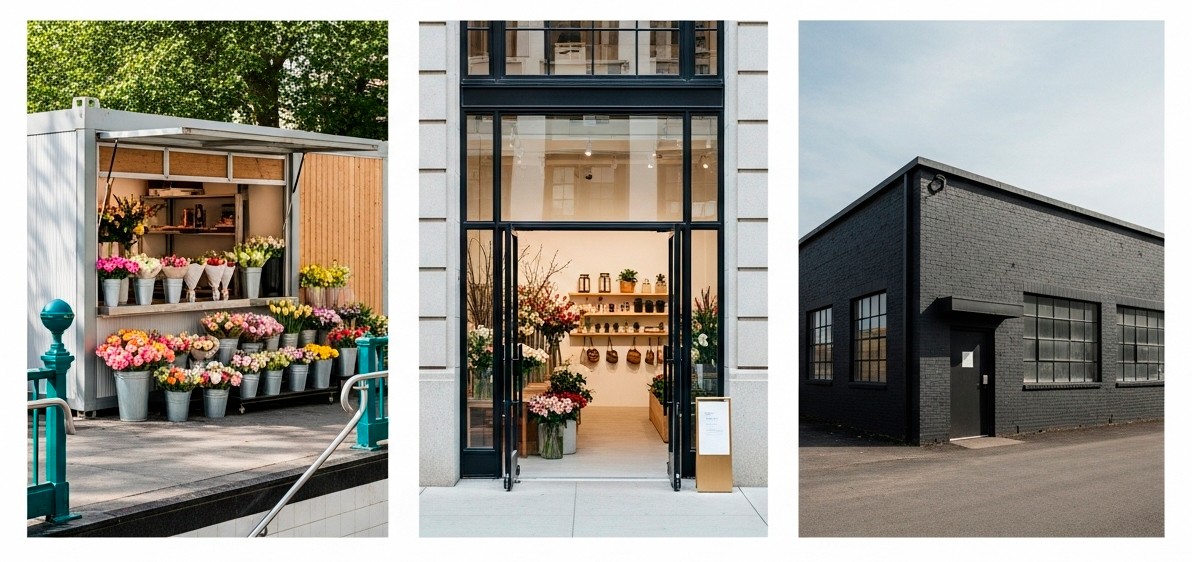
The choice of store format directly affects the cost structure, as well as the speed of reaching the break-even point.
Pavilion, Salon-Studio, or "Online + Dark Store"
Each format has its own specifics:
| Format | CAPEX* | Advantages | Limitations |
|---|---|---|---|
| Pavilion (15–25 m², near metro) | 1.2–1.8 million RUB | High 24/7 foot traffic, impulse purchases | Restrictions on window dressing, trade levy |
| Salon-Studio (40–60 m², street retail) | 3.5–4.5 million RUB | Brand image, workshop area, upselling plants | High rent, need for a full staff |
| Dark Store + Online (30–40 m², Class C warehouse) | 2–3 million RUB | Minimal rent, scalable 24/7 delivery | No storefront, requires strong SEO |
*CAPEX refers to one-time capital expenditures for launching a business: renovation, equipment, signage.
Location Criteria: Traffic, Visibility, and Cooling Capacity.
To ensure a steady flow of customers and optimize logistics, it's important to consider:
- Foot traffic—at least 8,000 people per day for a pavilion, 5,000 for a salon.
- Point visibility—a storefront at least 4 meters wide, with a viewing angle of at least 120°.
- Cooling capacity—on average, 1 m³ of cold room space for every 50 bouquets on a peak day.
- Logistics—possibility of early morning deliveries and easy access for couriers without a pass system.
Rental Checklist
Before signing a lease agreement, it's worth checking these key conditions:
- Lease term of at least 11 months with the right of renewal.
- Provision of a rent-free period (1–2 months) for renovations.
- Permission to install an exhaust system and refrigeration equipment larger than 2 m³.
- Landlord's consent to install outdoor signage in accordance with local regulations.
- Mandatory civil liability insurance.
The final version of the article plans to include a lead magnet: a PDF checklist "15 Questions to Ask a Landlord Before Signing a Lease." (Other checklists may also be included, displayed on a rotating basis or in different parts of the article)
Supply and Logistics
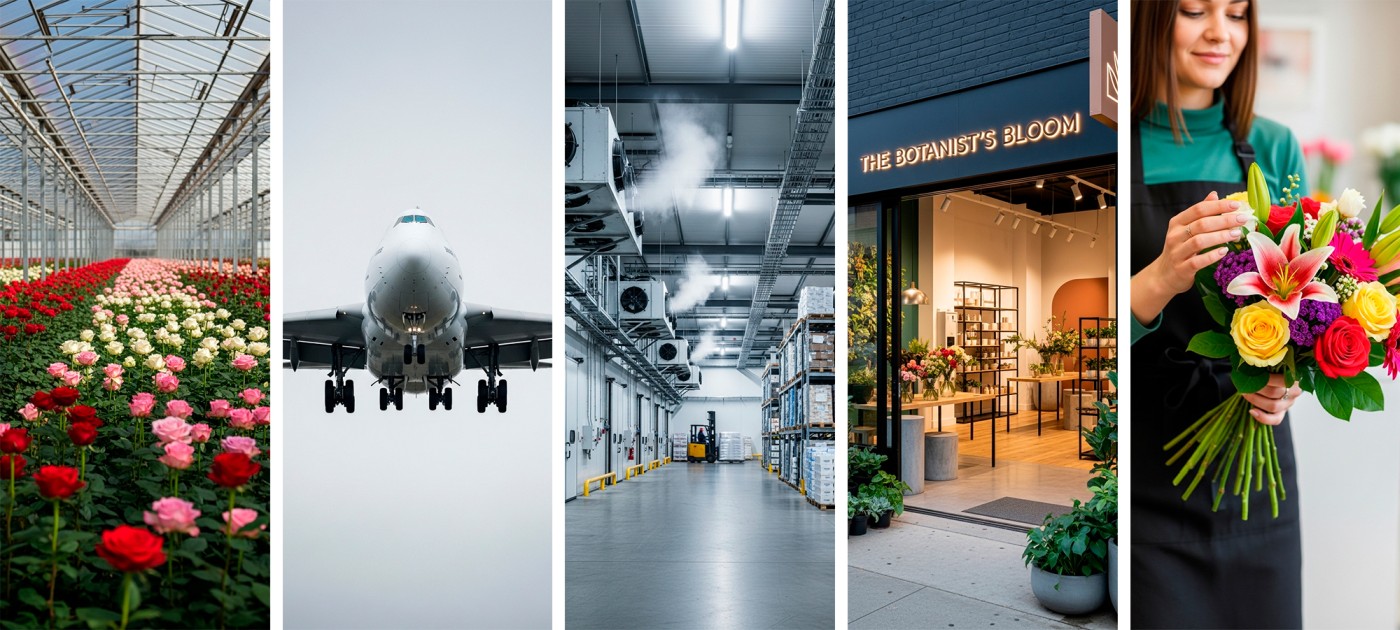
Organizing supplies is one of the key success factors in the flower business. The right choice of supplier and well-established logistics determine not only the product range but also the level of waste, profitability, and customer satisfaction.
How to Choose a Reliable Supplier
A reputable supplier minimizes the risk of incomplete shipments, delayed deliveries, and financial losses. When choosing, it's important to rely on the following criteria:
- History and reputation. Check through customs databases, dealer reviews, and public registries. Minimum of three years in the market.
- Turnover speed. The less time that passes between cutting and delivery, the higher the product quality and the lower the arrival losses.
- Infrastructure. Having a dedicated cold storage warehouse or cross-docking facility at major transport hubs like Sheremetyevo or Pulkovo ensures a stable temperature regime.
- Service level. Ability to track orders online, provide photos of flowers before packing, and offer payment deferral of at least 7 days.
- Replacement guarantee. Unconditional replacement of goods within 24 hours if defects are found in a batch (more than 3%).
Imports vs. Local Suppliers: What to Choose
The right balance between imports and local producers helps optimize the assortment and maintain profitability.
| Parameter | Imports | Local Producers |
|---|---|---|
| Market Share | 78% of sales volume (data from RBC Marketing) | 22%, growing by 2–3 p.p. per year |
| Seasonality | Year-round assortment: roses, alstroemerias | Season from May to September; limited assortment |
| Transit Time | 2–15 days | 12–24 hours |
| Profit Margin | 35% | 40–45% (lower logistics costs) |
Local producers are advantageous for creating an "eco-friendly assortment" with a higher margin. However, they cannot yet fully replace imports. The optimal purchasing strategy is a mix of 70% imports and 30% local flowers, which allows for a stable year-round availability of core varieties and a quick response to seasonal trends.
Assortment and Inventory Management
A well-structured assortment allows for high turnover, reduced write-offs, and effective engagement with different target segments.
The 60-20-10-10 Product Matrix
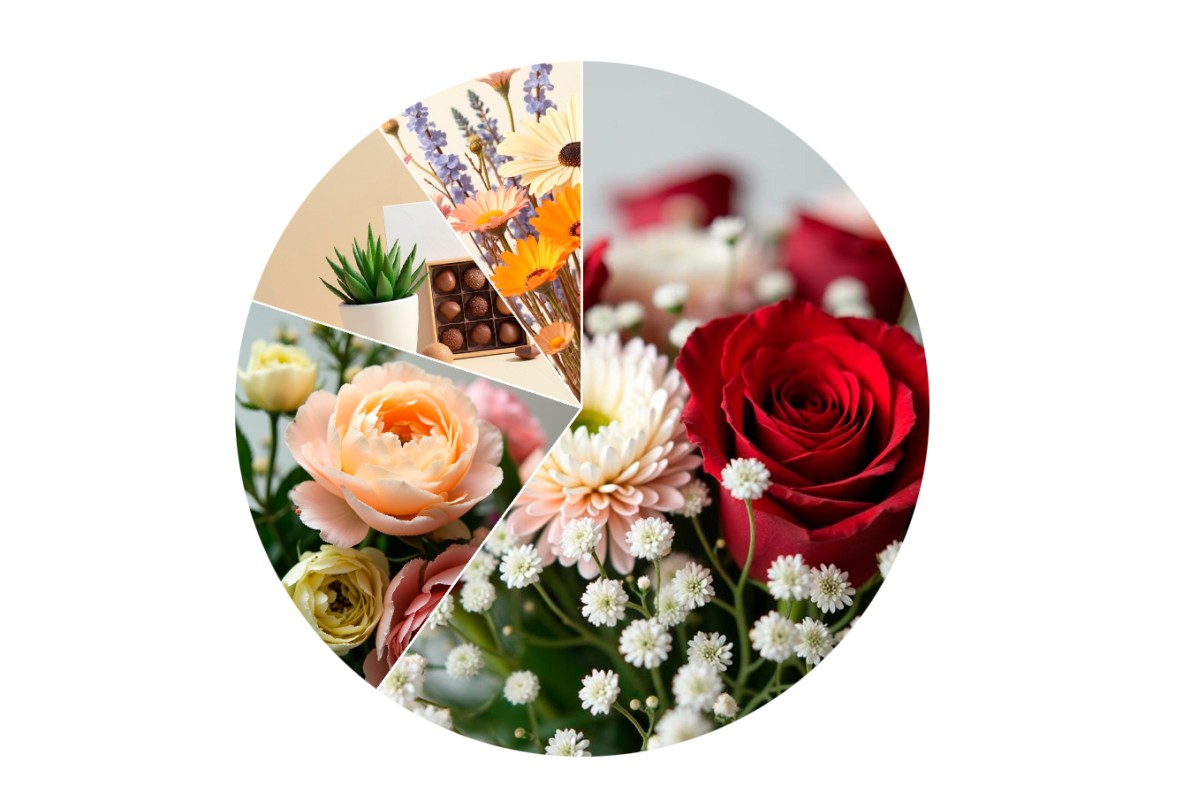
An assortment structure proposed by "TBank Secrets" (source):
| Share | Content | Purpose |
|---|---|---|
| 60% — Core. Best-selling items, stable demand. | Roses, spray chrysanthemums, gypsophila | Stable turnover, baseline revenue |
| 20% — Growth. Promising products that could capture a larger share in the future. | Peony roses, ranunculus, premium greenery | Increasing the average check |
| 10% — Trend. Fashionable, current new arrivals. | Dried flowers, dyed arrangements, mono-bouquets | Attracting a new audience |
| 10% — Impulse. Items for spontaneous, attention-grabbing purchases. | Chocolate, greeting cards, mini-plants | Upselling at checkout and through delivery |
This balance helps cater to both regular customers and those looking for something unusual.
Seasonality and Demand Forecasting
Understanding seasonal trends allows for adjusting orders and minimizing costs:
- Spring — tulips, daffodils, ranunculus (February–March).
- Summer — peonies (until July), alstroemeria, lisianthus.
- Autumn — dahlias, chrysanthemums, ornamental cabbage.
- Winter — amaryllis, imported "Ecuador" roses.
The trend for custom-designed bouquets continues to gain momentum: in 2024, their share in private orders reached 38% (RBC Style).
Storage Methods: FIFO and Cold Room Conditions
Effective inventory management reduces write-offs and increases profitability:
- FIFO (First In, First Out) — the principle of selling the first-arrived stock first. Bouquets are marked with colored stickers according to their arrival date.
- Temperature Control — storing at +2…+6 °C with 80–90% humidity slows down the plants' metabolism, extending their shelf life by 25–30% (Chrysal Code of Practice).
- Disinfection — regular cleaning of cold rooms reduces the risk of gray mold (Botrytis) development.
Minimizing Write-offs: The D-3 Discount System
Well-configured discounts help sell products before they spoil. D-n is a model where "D" stands for the day of goods receipt, and the number indicates how many days have passed:
- D-1 — sale at standard price.
- D-3 — a 15% discount on bouquets from this batch, actively promoted through push notifications and social media.
- D-5 — write-off or donation to charitable organizations (with the possibility of a tax deduction).
Applying this markdown pricing model can reduce the write-off rate to 4–5% of the gross purchase volume, compared to the standard 8–9%.
Marketing and Brand Strategy
Even a perfect assortment and a prime location will not yield results without systematic marketing. The flower business is an emotional market where brands that can build trust, create a memorable visual identity, and engage audiences across different channels win.
Positioning and Brand Identity
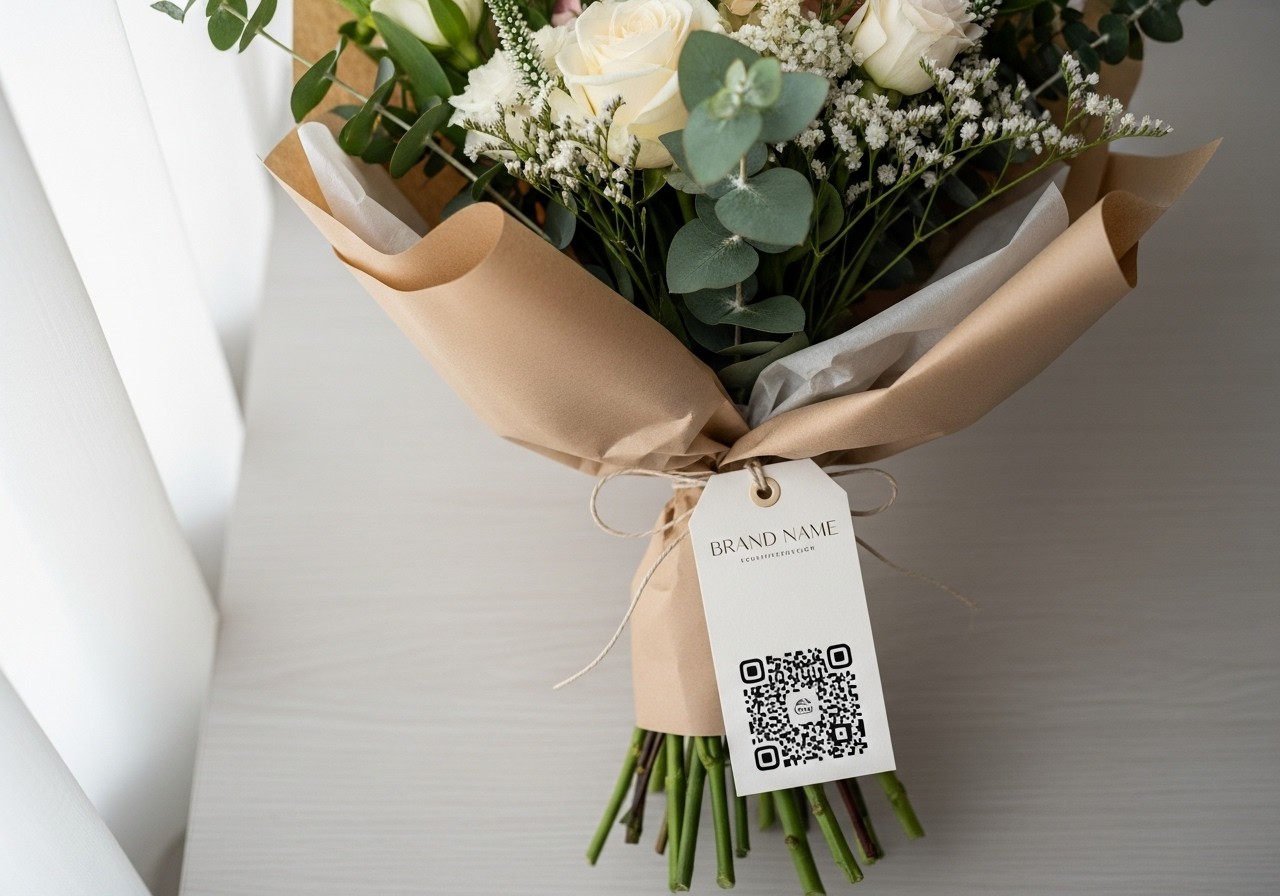
A modern flower shop builds its communication around occasions and emotions, not discounts. The brand's foundation is the value of the moment: a complimentary gift, an interior arrangement, an event accessory. Price becomes secondary.
The visual identity must be clearly defined: use two primary brand colors and one accent color that enhances the bouquet rather than clashing with it. In practice, these are often neutral shades: gray, warm beige. The logo is monochrome to avoid distracting from the composition's content.
The brand's tone of voice combines business-like precision with a trustworthy approach. For example, when describing a custom bouquet, it's acceptable to explain terms: "Ranunculus—a garden rose without thorns," instead of a dry list of varieties.
Packaging as a marketing channel is a growing trend: for example, craft film with a QR code leading to short Reels with bouquet care life hacks increases repeat sales.
Digital Marketing: Social Media, Video Content, and Local SEO
A strong presence in digital channels has become a mandatory requirement for flower retail. The focus is on short-form video content and local visibility:
| Channel | Tactic | KPI |
|---|---|---|
| Instagram* / VK | 2–3 Reels or "Clips" per week: assembling a bouquet in 60 seconds, behind-the-scenes with florists | ER ≥ 4%, CPM ≤ 85 RUB |
| YouTube Shorts | 30–40-second videos: history of a variety + care life hacks | Watch Time ≥ 65% |
| Local SEO | Title and H1 optimization ("Flowers + district"), setting up UTM for Yandex.Maps | Click-to-Call rate ≥ 8% |
| E-mail & SMS | Automated triggers: care reminders and new collections | OR ≥ 38%, CR ≥ 5% |
Note on the table: ER — engagement rate, CPM — cost per mille, Click-to-Call rate — percentage of clicks on the "call" button, OR — open rate, CR — conversion rate, Watch Time — percentage of the video watched by users.
It is important to note: social media algorithms in 2024–2025 prioritize short-form video content. Actively publishing 2–3 Reels per week increases organic reach by 35–40% compared to a classic photo feed.
Offline Activities and Partnerships
In addition to digital channels, local offline events are effective:
- Workshops on assembling a bouquet in 30 minutes with a 1,500 RUB ticket quickly cover the cost of expensive varieties.
- Collaborations with coffee shops: a joint display and cross-discounts on flowers and coffee increase customer traffic.
- "Corporate Flowers" B2B subscription: a fixed weekly delivery of arrangements to offices for a 12,000 RUB/month fee.
These formats enhance local brand awareness and increase customer lifetime value.
Metrics: CAC, LTV, NPS
Marketing effectiveness is not evaluated intuitively but through specific indicators:
| Metric | Formula | Acceptable Benchmark |
|---|---|---|
| CAC | (Advertising Spend + Marketing - Payroll) ÷ Number of New Customers | 1,400–1,800 RUB |
| LTV | Average Check × Purchase Frequency × Gross Margin | 12,000–15,000 RUB |
| NPS | % Promoters – % Detractors | ≥ 55 |
Note on the table: CAC (Customer Acquisition Cost) is the cost of acquiring a single customer. LTV (Lifetime Value) is the total value of a customer, calculated based on average revenue and profitability. NPS (Net Promoter Score) is a loyalty index, measured by the difference between the percentage of promoters and detractors.
Monitoring these metrics helps optimize acquisition channels, improve service quality, and increase the share of returning customers.
Operational Processes and Personnel
Without clear procedures and a trained team, even the most beautiful bouquets may not reach the customer in the right condition.
Daily Procedures (Receiving, Trimming, Displaying)
Standard operating procedures minimize write-offs and maintain quality:
- Receiving — check stem length, bud openness, and bouquet temperature (≤ 7 °C).
- Trimming — mandatory 45° cut under water, treated with 0.05% chlorhexidine to reduce bacterial load.
- Displaying — sort bouquets by age: fresh batches are placed at the back of the display, while D-3 bouquets are moved closer to the customer to encourage discounted sales.
Recruiting and Training Florists
A strong team is an investment in long-term success:
- Junior — up to 6 months of experience.
- Middle — 6–24 months of experience.
- Senior — over 2 years + leads creative projects.
Florists are trained on up-sell scripts ("Let's add eucalyptus—the scent lasts longer, +180 ₽"), which yields an additional sales conversion rate of 32%. Mandatory training is held quarterly on trends, speed-bouquet techniques, and sales.
KPIs for staff:
- Average check.
- Percentage of additional sales.
- Customer loyalty (NPS by florist's name via QR surveys on receipts).
Delivery Service: In-house Logistics vs. Outsourcing
| Indicator | In-house Courier | Outsourced Courier Service (Yandex Go, SDEK, Dostavista, etc.) |
|---|---|---|
| CAPEX / Startup — initial capital expenditures: renovation, equipment, cash registers, refrigerators. | 350,000 ₽ (scooter, terminal, CRM access) | 0 ₽ |
| Delivery Cost — logistics expenses from the wholesale base or supplier to the store. | 150–200 ₽ within a 5 km radius | from 180 ₽, depends on distance and time of day |
| SLA (Service Level Agreement) — the level of service the provider commits to (e.g., terms and conditions of flower delivery). | 90 minutes (city), 180 minutes (suburbs) | 60–120 minutes, depends on the contractor |
| Peak Load — periods of sharp order increases (March 8, February 14), when it's crucial to have sufficient stock and staff. | Up to 20 orders per day per courier | Scalable to hundreds of orders per day |
| Features | Full control, branded packaging, CRM integration | Less control, but greater flexibility |
In-house couriers are practical for high order density in a limited area. They allow for service control, use of branded packaging, and encourage repeat purchases. However, scaling this model requires investment and personnel management.
Outsourcing delivery is beneficial at the start, with unpredictable volumes, or when serving an entire metropolitan area. It eliminates expenses for transport, insurance, and holiday peak loads.
Important!
The Cargo Flowers platform provides international logistics from supplier countries (Ecuador, Kenya, Colombia, etc.) to Moscow, including shipment consolidation, temperature control, and customs clearance. Flower shops in Moscow receive flowers already sorted and ready for processing and sale.
Team and HR Strategy
Even with a strong product and well-organized logistics, it is the team that determines how the business will develop in the long term. A flower shop is essentially a service business, and the level of staff engagement directly impacts the average check, number of repeat orders, and customer reviews.
Key Roles and Responsibilities
Team organization begins with understanding the functions of key positions. Below is an approximate list of roles, their tasks, and current salaries (according to hh.ru, March–April 2025):
| Role | Main Function | Salary (Moscow / Regions) |
|---|---|---|
| Store Manager | Financial model (P&L), purchasing, scheduling, reporting | 90,000–120,000 / 60,000–80,000 |
| Senior Florist | Creative direction, training, assembling VIP orders | 70,000–100,000 / 45,000–80,000 |
| Florist | Assembling bouquets, customer service | 70,000–100,000 / 45,000–70,000 |
| Administrator-Cashier | Display arrangement, inventory management, FIFO control | 40,000–55,000 / 28,000–40,000 |
| In-house Courier | Last-mile delivery, cash collection | 180–220 ₽/delivery |
| Digital Marketer | SMM, CRM campaigns, lead generation | 80,000–110,000 / 55,000–75,000 |
| Accountant (Outsourced) | FTS reporting (tax documentation), payroll project | 12,000–18,000 |
Schedules and Employment Models
The team's work format depends on the type of retail location:
- 24/7 Pavilion — 2/2 schedule with 12-hour shifts, staffed by 1 florist + 1 cashier, with a shift courier added during peak loads.
- Salon-Studio — standard 5/2 schedule with 9-hour shifts, minimum staff: 2 florists and an administrator, with delivery handled by a contractor.
When planning staffing, it's important to consider: 100 bouquets per day require 1 florist + 0.4 couriers. Each additional 50 bouquets require another assembly assistant.
Motivation and Development
The level of service in a shop grows not from penalties, but from a well-structured motivation system and a culture of training:
- Margin Bonus — 5% of the shift's gross profit is divided among florists; encourages a focus on upselling.
- Cross-Training — the senior florist conducts a master class for the team once a month. Completion adds +5% to the salary.
- Gamification — a monthly leaderboard (by NPS, upsell, assembly speed); the quarterly prize is a bonus equal to 50% of the salary.
- Onboarding — a "10 Steps for a Newcomer" checklist + a mentor from the senior florists. This reduces turnover in the first year.
Labor Protection and HR Administration
Correctly registering employees protects the business during inspections and reduces legal risks:
- All employees are registered according to the Labor Code of the Russian Federation (FZ-197).
- Tracking of work experience and benefits.
- Mandatory logs for occupational safety and sanitation briefings (updated annually).
- Video recording of the receiving area helps prevent hidden write-offs and resolve disputes.
Outsource vs. In-house
Not all functions are best kept within the company—some tasks are more effectively outsourced:
| Function | In-house, if… | Outsource, if… |
|---|---|---|
| Courier Service | Delivery within a 5 km radius, volume ≤ 60 orders per day | Operating across the entire metropolitan area, peak loads (March 8, etc.) |
| Accounting | Annual turnover > 200 million ₽ | Startup < 50 million ₽, no complex reporting |
| SMM (Social Media Marketing) | A constant stream of "insider" content is needed | A posting schedule and Reels with external production are suitable |
Technologies and Automation Tools

Scaling a flower business is impossible without an IT infrastructure: CRM, POS systems, automated accounting, and omnichannel communications.
POS Systems, CRM, and Omnichannel
| Task | Solution | Why It's Important |
|---|---|---|
| In-store Sales | Evotor, ATOL Sigma, YooKassa, Litebox POS | Integration with cash registers, labeling, acquiring fees as low as 0.9% |
| Accounting and CRM | RetailCRM, amoCRM, Saby, Posiflora | Customer segmentation, purchase history, cross-selling |
| Omnichannel | VK Connect, Telegram bots, WhatsApp Cloud API | Processing orders from all channels in a single interface |
Marketplaces for Selling Flowers
Flowwow is one of the largest flower delivery services, covering over 950 cities in Russia. It provides sellers with a mobile app, instant payouts, and an API for accepting online payments and automatically printing receipts.
FloMarket brings together over 1,000 flower shops across the country. It offers a free storefront for products in the "flowers + gifts" category, as well as integrations with Evotor and fiscal data operators (OFD) for correct online reporting.
Florist.ru has been operating since 1999 and unites about 700 partner salons. It provides its own delivery service and support for international orders, which can be useful for expanding the audience.
Flor2u delivers orders throughout Russia, starting from 2 hours. Sellers have access to a photo-check feature for bouquets before dispatch, as well as the option to join without a fixed entry fee.
In addition to specialized platforms, flower shops can expand their reach by listing products on large general marketplaces. These platforms provide high traffic, developed logistics, and brand recognition:
Wildberries is the largest online retailer with a broad "Flowers" category, including live, preserved, and indoor plants. Sellers gain access to a mass audience, can use daily payouts, and leverage built-in logistics to the customer.
Ozon is actively developing the fresh and gift bouquet segment. The platform offers storefronts with fast "same-day" delivery, flexible pricing options, and convenient storage and shipping models (FBO, FBS).
SberMegaMarket offers delivery of flowers and gifts starting from 2 hours, as well as integration with Sber's banking ecosystem. It is well-suited for shops focused on fast delivery in major cities.
Yandex Market is a platform with powerful search traffic, where the flower category is predominantly represented by houseplants and dried flowers. In large cities, bouquet delivery is available through "Yandex Lavka," which can be a plus for shops with fast logistics.
Combining a proprietary website with marketplaces reduces dependency on a single channel and increases resilience to changes in search algorithms.
Planned Software and Modules
For flower shops planning to expand their network or increase turnover, it makes sense to launch basic internal tools—first as an MVP (Minimum Viable Product), and then expand their functionality.
| Module | Function | MVP Task |
|---|---|---|
| Procurement | Managing orders, monitoring cutting dates | Daily inventory checklist + Excel form for price requests |
| Warehouse/FIFO | Tracking batches, shelf life, write-offs | Push reminder for D-3 discounts |
| Assembly | Controlling composition and speed of bouquet assembly | "Bouquet in 60 sec" template checklists |
| Delivery | Tracking and monitoring routes | Integration with Yandex Go, Dostavista, or SDEK |
| BI Dashboard | Financial and operational analytics | Metabase dashboard: revenue, write-offs, CAC, LTV |
Even minimal modules allow for tracking sales dynamics, identifying losses, and adjusting team performance in real-time—without having to "live in Excel."
Proprietary Website
Even with an active presence on marketplaces and social media, a website is a key asset that allows you to control traffic, collect customer data, and not depend on third-party algorithms.
The main tasks a flower shop's website solves:
- Brand Presentation: storefront, values, expertise, visual style.
- Catalog with a shopping cart: the ability to order a bouquet online without switching to a messenger.
- Delivery Integration: automatic calculation of courier service time and cost.
- Lead Generation: subscription forms, pop-ups with promotions, callback widgets.
- SEO Traffic: attracting customers from Yandex and Google through queries like "bouquet + district (city)."
On a limited budget, a ready-made platform like Tilda or Insales with basic cart, payment, and logistics integration will suffice. As the business grows, you can switch to a custom CMS and CRM integration.
It is recommended to create separate pages for:
- Bouquet selections by occasion (wedding, birthday, apology, etc.)
- A catalog with filters for price, color, and delivery time
- A blog: care tips, selections, trends—improves SEO and engages visitors
- Local landing pages for different city districts (improves search visibility)
A website is not just a business card, but a long-term tool for attracting and retaining customers. With a well-structured site and regular updates, it can generate up to 30–40% of the total order flow within 3–5 months of operation.
Sustainability
In 2025, a "green" approach is becoming not just a trend, but a competitive advantage. The flower business can implement sustainable practices even without significantly increasing logistics or packaging costs. Moreover, these solutions provide businesses with additional customer loyalty and a price premium.
Certified Plantations and Eco-Suppliers
About 70% of imported flowers come from Ecuador, Kenya, and Colombia. Over 700 farms in these countries are already certified under the Rainforest Alliance standard, which guarantees:
- limited use of agrochemicals;
- monitoring of labor conditions;
- protection of biodiversity.
When working with local greenhouses, it is worth clarifying the presence of a closed-loop irrigation system and LED lighting: such technologies reduce energy consumption by up to 35% and make production more resilient to climate risks.
Sustainable Packaging and Water Reuse
Biodegradable materials are not a myth, but an available solution:
- PLA (polylactide) film or craft paper made from 80% cellulose;
- paper tape instead of plastic;
- avoiding shiny ribbons and decorative elements based on PVC.
From 2025, plastic bobbins will be subject to an environmental fee: according to recycling regulations, at least 55% of packaging plastic must be recycled (RBC Trends).
To save water, many shops use a closed-loop water system—where the same buckets of solution are not emptied daily but are reused. Special tablets with an antiseptic effect (e.g., Chrysal CVBN) are added to the water to inhibit bacterial growth. This solution can be used for up to 5–7 days without harming the freshness of the flowers. This reduces water consumption by about 30–50% compared to the usual method of changing the water daily.
How to Communicate a "Green" Approach to Customers
Environmental consciousness must not only be implemented but also properly communicated to the customer:
- Labels with eco-icons.
- A QR code leading to a page with metrics (e.g., "we saved 14 kg of plastic in March").
- Social media content — Reels about composting, Stories on "a bouquet's second life" in interior design.
- Partnerships with eco-projects — for example, donating 1 ₽ from each bouquet to a local greening fund.
According to industry research, 43% of customers are willing to pay up to 10% more for a bouquet that is assembled and packaged in compliance with environmental standards.
FAQ
How much does it cost to open a flower shop?
| Format | Area | CAPEX, ₽ | Main Expense Items |
|---|---|---|---|
| Pavilion near a metro station | 15–25 m² | 1.2–1.8 million | Renovation, refrigerated display, POS, initial stock purchase |
| Salon-Studio | 40–60 m² | 3.5–4.5 million | Interior design, 4 m³ cold room, workshop area, staff room |
| Dark Store + Online | 30–40 m² | 2–3 million | Refrigerator, packaging line, photo zone |
| Premium Studio (Moscow) | 60 m²+ | ≈ 5 million | Design, digital display, expanded staff |
The most expensive items are: refrigeration equipment (≈25%), the initial purchase of flowers (≈30%), and renovations (≈20%). With skillful negotiation, you can secure a rent-free period, which can reduce the initial budget by up to 15–18%.
What documents are needed to sell flowers?
- Sole Proprietorship or LLC with OKVED code 47.76.1;
- Lease agreement or property ownership documents;
- Supplier contracts + phytosanitary certificates;
- Online cash register with a fiscal drive (54-FZ);
- Contract for the disposal of Class B waste (plant remains);
- Signage project approved by local regulations (e.g., 902-PP for Moscow).
Flowers are not on the list of licensed goods. The "Honest SIGN" system does not yet apply to floristry.
Which refrigerator should I choose?
- Type: a "coupe" style chamber with transparent doors or a monoblock unit in a separate room.
- Volume: ≈ 1 m³ for every 50 bouquets in peak display.
- Temperature: from +2 to +6 °C, humidity 80–90%.
- Power: with a 25% reserve for summer peaks and frequent openings.
- Options: supply and exhaust ventilation, UV lamp against Botrytis, digital thermostat with SMS alerts.
Conclusion
Launching a flower shop is about more than just flowers. It's a business where logistics, automation, customer focus, and visual storytelling intertwine. And all of this is set against a backdrop of high seasonality and the need for quick reaction times.
What's important to remember:
- Strategic planning and segmentation shorten the path to profitability by at least 2 months.
- Reliable logistics and a mix of suppliers (import + local) help maintain a margin of 35%+.
- 360° marketing (Reels, local SEO, subscriptions) reduces CAC to 1,400 ₽ and increases LTV above 12,000 ₽.
- Automation (FIFO, CRM, proprietary website) saves resources and cuts write-offs in half.
- Sustainability and transparency build trust: an eco-friendly approach increases NPS, and therefore, repeat sales.

